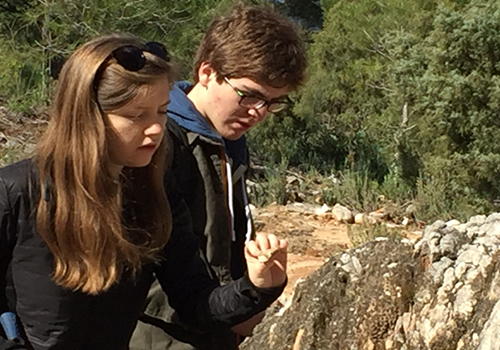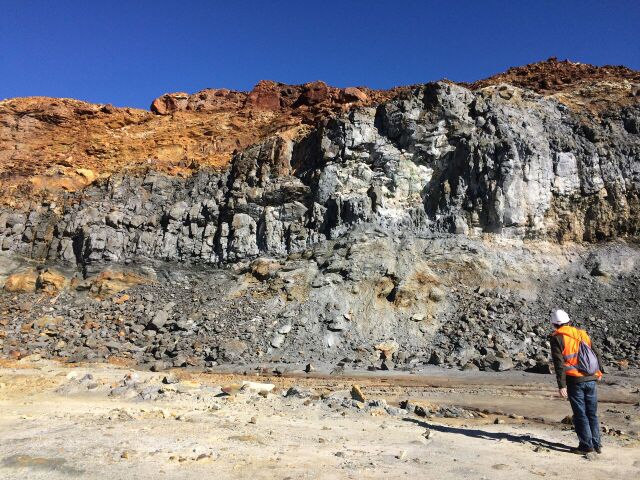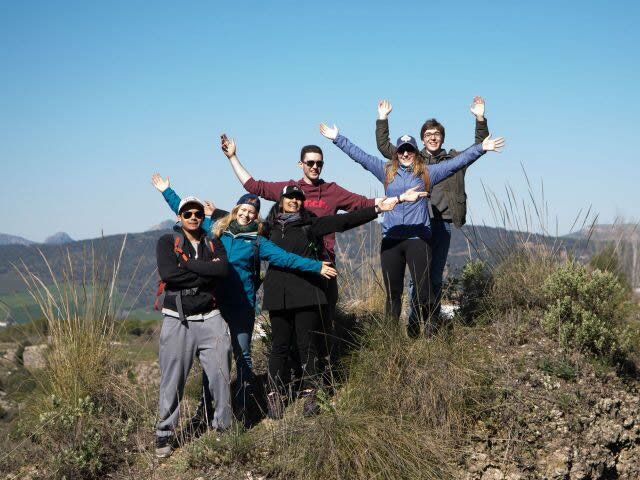“We can talk about all these tectonic events and floods, but until you see it for yourself, you can’t make all the interpretations you need to,” says University of Toronto Earth Sciences PhD student Benjamin Moulton, fresh from a hands-on field trip to Spain with second and fourth year undergraduates.
This past February, Moulton, U of T Earth Sciences professor Grant Henderson, and Masters candidate Cheyenne Sica led 20 students on a rockhound’s dream, exploring the waters of the Rio Tinto (Red River) in Andalusia, the multi-layered Ronda Peridotite, the soaring cliffs of Gibraltar, and the breathtaking beauty of the Alhambra UNESCO World Heritage Site.
First stop was an open pit along the Rio Tinto, an area that’s been mined for more than 2,000 years for copper, iron, manganese, gold and silver.
“The whole area was spectacular,” says Moulton. “Students got to see Roman-age slag — the melted glass-like by-product left behind after gold was extracted — directly beside a modern open pit.”
Acid mine drainage from heavy metal concentration and the acidity of the rock in the area has turned the waters of the Rio Tinto river blood red.
Behind the scenes of responsible mining
“This mining area has been an environmental disaster for some time,” says Moulton. “Part of the problem is man-made from centuries of mining activity. But another part is the rocks themselves. They’re particularly acidic; the water pH is about 2, which means that only extremophiles live in it.”
The Rio Tinto mine closed in 2001, but the EMED Tartessus mining company started a project using the previous company’s open pit, which needed to meet modern standards for environmental impact and reclamation.
“That was a big part of what made the trip so fascinating,” says Moulton. “It was an impressive show of a modern mine carrying out its environmental responsibilities to the highest degree and one of the best communication connections to the community I’ve ever seen. It really helped give context and honesty to the students’ conversations around the impact of the mine.”
Mantle making in action

Day two brought the exploration of the Ronda Peridotite, a slice of the Earth’s mantle that has protruded into a massif under a thin layer of crust in a series of tectonic events.
Younger than other similar peridotites around the world, the Ronda Peridotite has three distinct levels of structure that allow study of the mechanical behaviour of the mantle during mountain formation.
“It just has great exposure, from what’s above it to what’s underneath the full peridotite sequence, which is so rare,” says Moulton.
“You can see what your textbook says you’re supposed to see, right in front of you, standing in the field. It’s an amazing cross section of the continental crust.”
Cultural context and flooding the Mediterranean
After touring the Alhambra UNESCO World Heritage site, an Islamic palace (rumoured to be the place where Christopher Columbus got the nod from Isabella and Ferdinand to start his voyage of discovery) on day three, the students toured the famed limestone promontory of Gibraltar on day four to learn the geologic history of the Mediterranean.
In an arid environment with a high rate of evaporation, the Mediterranean dried up during the Messinian salinity crisis.
“Then about 5.3 million years ago, the Zanclean flood caused water from the Atlantic Ocean to fill the Mediterranean Sea through the Gibraltar Strait,” says Moulton.
“Estimates are that the flood had a volume three orders of magnitude (or a thousand times) more than the discharge of the Amazon River.”
“Is field work for me?”
For their final day in the field, students returned to the Ronda Peridotite, with fourth years showing second years how to take measurements in the field and evaluate rocks in different contexts, including their economic potential and scientific interest.
The day was the culmination of a trip that solidified several students’ academic plans, with several mentioning that they learned more in these five days than they did in the previous semester.
“For most students thinking of going into geology, this was their first opportunity to be in the field,” says Moulton. “When they get out here, some people find it’s not for them, others love it.”


All photos courtesy of Benjamin Moulton.

